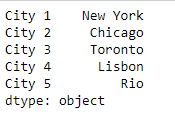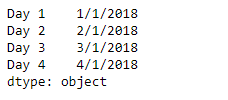Python | Pandas Series.values
Python - отличный язык для анализа данных, в первую очередь из-за фантастической экосистемы пакетов Python, ориентированных на данные. Pandas - один из таких пакетов, который значительно упрощает импорт и анализ данных.
Серия Pandas - это одномерный массив ndarray с метками осей. Этикетки не обязательно должны быть уникальными, но должны быть хешируемого типа. Объект поддерживает индексирование как на основе целых чисел, так и на основе меток и предоставляет множество методов для выполнения операций, связанных с индексом.
Pandas Series.values attribute return Series as ndarray or ndarray-like depending on the dtype.
Syntax:Series.values
Parameter : None
Returns : ndarray
Example #1: Use Series.values attribute to return the values in the given series object as an ndarray.
# importing pandas as pdimport pandas as pd # Creating the Seriessr = pd.Series(["New York", "Chicago", "Toronto", "Lisbon", "Rio"]) # Creating the row axis labelssr.index = ["City 1", "City 2", "City 3", "City 4", "City 5"] # Print the seriesprint(sr) |
Выход :
Now we will use Series.values attribute to return the values of the given Series object as an ndarray.
# return an ndarraysr.values |
Выход :

As we can see in the output, the Series.values attribute has returned an ndarray object containing the values of the given Series object.
Example #2 : Use Series.values attribute to return the values in the given series object as an ndarray.
# importing pandas as pdimport pandas as pd # Creating the Seriessr = pd.Series(["1/1/2018", "2/1/2018", "3/1/2018", "4/1/2018"]) # Creating the row axis labelssr.index = ["Day 1", "Day 2", "Day 3", "Day 4"] # Print the seriesprint(sr) |
Выход :

Now we will use Series.values attribute to return the values of the given Series object as an ndarray.
# return an ndarraysr.values |
Output :
As we can see in the output, the Series.values attribute has returned an ndarray object containing the values of the given Series object.
Внимание компьютерщик! Укрепите свои основы с помощью базового курса программирования Python и изучите основы.
Для начала подготовьтесь к собеседованию. Расширьте свои концепции структур данных с помощью курса Python DS. А чтобы начать свое путешествие по машинному обучению, присоединяйтесь к курсу Машинное обучение - базовый уровень.